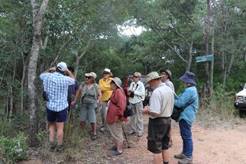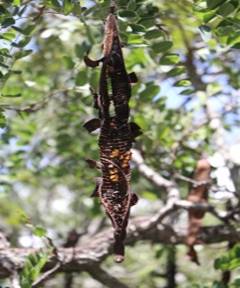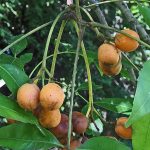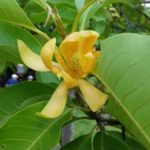TREE LIFE
MARCH 2018
MASHONALAND CALENDAR
Saturday March 3rd : Botanic Garden Walk. Meet in the car park at 8.30am for an interesting hour and a half walk in this beautiful garden.
Sunday March 18th : OUTING TO RUWA: Rowan Martin, of National Parks and bag piping fame, has kindly agreed to guide us around his very interesting property in Ruwa. Over the years many indigenous trees have been planted on this property and there is also a kopje to explore and a pretty dam beside which to have our picnic lunch (rain depending). Don’t miss this interesting outing. Bring your lunch and cooler bag, chair, hat etc. Meet at 9.45am or for those wanting a lift, or offering a lift, meet at the Mukuvisi car park at 8.45am.
Saturday March 27th : Venue to be advised.
GUMS FROM PLANTS
Taken from Tree Society of Rhodesia Newsletter August 1979
I expect we have all wondered from time to time why trees like Acacia karroo produce gum and just what it is. This is an attempt to give some sort of answer and also to draw attention to the continuing importance of natural gums.
The ‘what’ is easy to answer, though in a rather dull, technical way! The analytical chemists have been busy and the composition is known with great accuracy. They are essentially ‘polyuronides’ consisting of sugar and uronic acid units. Some gums have methoxyl groups, e.g. Tragacanth; in others the acid complex is united with metals, e.g. Acacia. This means that they are carbohydrates similar to starch and cellulose, and closely related to a large number of other well known sticky substances. Pectin and agar are examples.
The ‘why’ is more difficult. The reason usually given in botany text books is that it is a protective response to wounding. By filling up the wound with gum, disease organisms are excluded, until new tissue can be grown over the wound. But this does not explain why some trees yield gum, others resins, and others nothing at all. Yet all types successfully survive injury. The ‘scientific’ explanation would probably go something like this: the production of protective gum confers an advantage that enables certain genes to survive into the next generation. Remember, in terms of evolution, the survival of the genes seems to be the important thing. As one writer has recently put it : it is the egg which is important, not the chicken, or tree or whatever. The chicken is simply a machine the egg has made to produce more eggs, and so more genes!
In the face of such mental gymnastics I find the old view irresistibly attractive, namely that the gum yielding trees were made that way so that you and I would have something with which to stick things down !
As I have said, in a world of synthetics, the natural gums remain important articles of commerce. Even some “synthetics” are modifications of naturally occurring carbohydrates. Dexrin for example is made from starch. Of the natural gums the following are among the most important: Acacia gum, Tragacanth gum and Sterculia gum.
Acacia gum, Gum Arabic. As office gum this will be familiar to everyone, but it has a much wider use than this. My encyclopedia states that it is used in the manufacture of inks and confectionery, in textile printing, in ceramics, in leather processing and in pharmacy. I can vouch for its continuing importance in the practice of pharmacy where it is daily used to suspend insoluble powders in mixtures, and to make emulsions of oils in water, such as cod liver oil, ugh!! No doubt you have all suffered from these ministrations at one time or another. Many Acacias produce good gums but the chief source today is Acacia senegal. Sudan is the chief supplier. Some gum is collected from natural exudation, but the most esteemed Kordafan variety is obtained by tapping trees, about six years old, in February and March after the rains. Tapping is a simple matter of cutting the bark with an axe and pulling strips off above and below the cut. Tears of gum form in about a month and can be picked off and marketed. In the past Cape Gum from Acacia karroo was an important article of commerce. I recall that years ago it was collected by the Government Printer in Zomba, Malawi, and used to make office gum. A family of small rodents once lived in an old Acacia karroo in my garden. The tree is long dead and the rodents departed, but I recall that it dropped gum continuously, forming a sort of glassy plaque of gum at its base. The rodents were very partial to the gum, in fact it seemed to be their main food. So it must not be forgotten that the natural gums are also important articles of diet for some animals, including the Night Ape. A very similar gum is produced by apricots, now called Armeniaca vulgaris, which used to be Prunus. It is used medicinally in Russia for the same purposes as Acacia gum.
Tragacanth Gum. This fascinating gum will not be so well known. Like Acacia it is important to pharmacists as a suspending agent, as a binding agent in tablets and in the manufacture of gels. Very large quantities are used in calico printing and for making confectionery. It is obtained by incision of the stems of various species of Middle Eastern legumes of the genus Astagalus. These are thorny shrubs found in the mountainous districts of Asia Minor across to Iraq and southern Russia. Immediately on cutting the stem, gum gushes forth in a soft but solid stream. It can be collected after two days.
Sterculia Gum. This is also known as Kharaya gum or Indian Tragacanth and was at one time thought to be an inferior substitute for tragacanth. It has grown in importance of late years since it was shown to be superior for certain uses, particularly for making bulk laxatives. The powdered gum is also used in lozenges and dental fixative powders and as a medical adhesive. So it too has important medical uses. The source tree is Sterculia urens. It is produced in India, Pakistan and to a small extent in Africa. In our area Sterculia africana and S. quinqueloba both give similar gums but not in commercially exploitable quantities.
Many other plants yield gums and mucilages which have gained an enduring place in official and folk medicine, too numerous to include here, but I hope I have said enough for you to look at our trees with a renewed sense of wonder.
– E.B. BEST
A response to the above article by Miss Isobel McCalman of Essexvale, taken from Tree Society of Rhodesia Newsletter October 1979
ACACIA GUMS
Mr. Best speaks about the WHY being a protective response to wounding; but having been aware of this edible gum, (sindebele – inhlaga), for several years now I have kept a watchful eye on the exudation of such gum, during the course of my ethno-botanical investigations.
My small farm is in a schist belt with intrusions of epidiorite so I only have a few trees of Acacia karroo to watch and these are in the vicinity of the intrusion or red belt.
My observations are that (1) the gum is exuded only by Acacia karroo and not by A. nilotica, A. siebierana, A. rehmanniana, or A. robusta; and (2) that the gum of A .karroo has a value to local African groups as a form of sweet substance enjoyed by the younger children I have not discovered that the gum has been used in the area for any other purpose.
MBIZI GAME PARK AND LODGES, SUNDAY 21ST JANUARY
Mbizi Game Park is situated about 10kms past Harare Airport on the road past Kutsaga Tobacco Research Board. The group numbering 10 assembled at a side road about 200 meters from the entrance gate, in dense and very dry miombo woodland interspersed with large granite rocks. There was a large variety of species, many of which we do not often find.

Members botanising at Mbizi
The total number trees identified was 50 and these are some of the more unusual ones :
1. Psydrax livida – the green twigs with opposite decussate branches, opposite pinnae and fruits in pairs.
2. Ochna puberula – Granite Ochna – with simple, alternate small leaves.
3. Indigofera rhynchocarpa – a small shrub with distinctive pods looking like hockey sticks.
4. Osyris lanceolata – a widespread but not abundant shrub, occurs on rocky outcrops. The petiole runs down the stem.
5. Diospyros natalensis – Tickey Tree, a small tree growing in rocky areas with tiny, round leaves and fruit like acorns.
6. Maytenus undata – Koko Tree, dark green glossy leaves which when bent in half show a distinct white cuticle line.
7. Faurea rochetiana (previously F. speciosa ) – Broad-leaved Beechwood.
8. Bobgunnia madagascariensis (ex Swartzia) – re-named after Professor Bob Gunning by his students.

Cassia abbreviata pod
For the records, other species seen here were : Acacia sieberiana, Allophylus africanus, Brachystegia glaucescens and B. spiciformis, Burkea africana, Celtis africana, Clerodendrum eriophyllum, Combretum molle, Coptosperma neurophyllum, Crotalaria pallidicaulis, Cussonia arborea, Dichrostachys cinerea, Erythrina abyssinica, Erythrococca trichogyne, Euclea natalensis, Euphorbia ingens, Ficus natalensis, Ficus sur, Gardenia volkensii, Julbernardia globiflora, Lannea discolor, Monotes glaber, Ochna pulchra and schweinfurthiana, Parinari curatellifolia, Peltophorum africanum, Pittosporum viridiflorum, Pseudolachnostylis maprouneifolia, Psorospermum febrifugum, Pterocarpus rotundifolius, Searsia longipes, Senna singueana, Strychnos cocculoides, Tricalysia niamniamensis, Vangueria infausta, Vitex payos, Ximenia caffra, and Ziziphus mucronata.
The group then drove to the main entertainment centre by the dam where there was a large crowd of rather noisy visitors. We had a short walk and found Afrocanthium lactescens with large leaves, Flacourtia indica, Searsia tenuinervis and Cassia abbreviata.
We returned to the start of our first walk for our picnic lunch in the shade amongst the rocks where Mervyn Senior, the owner of Mbizi Park, welcomed us to the park and gave us a talk about the activities being carried out. All in all, a pleasant outing.
–Teig Howson
NATIONAL BOTANIC GARDENS WALK SATURDAY 3rd FEBRUARY 2018
Saturday 3rd started as a beautiful sunny morning and the Gardens were looking sparkling after some good rain. There was a good turnout of members – Jan, Bilal with a friend, Jim and Ann, Dawn, Meg, Mark, Tony, Yagan, Nanling, Junya, Alex, Isla, Stuart, Teig, Barbara and friend, Mary, Ryan Truscott and Chris Chapano.
Tony set off at a brisk walk while some of us lingered to identify the tree whose blossom littered the path near the entrance, a very attractive Markhamia zanzibarica, the Bean Tree, a straggly tree with striking flowers – yellow flecked with maroon. They can be grown from truncheons and grow easily from seed.
We then headed to the commercial section that surrounds the green houses and workshops, where Chris gave us an encouraging talk about the new projects and maintenance being carried out as part of the new changes in leadership. The government ministries have been given 100 days to prove their intentions to the public and as a result, the Botanic Gardens were seeing some positive changes. A new borehole has been drilled and there were future plans to resuscitate the pond as the water source for the gardens; they have new mowers, as well as electric saws and brush cutters.
We then inspected the trees in this section including a very large bamboo flowering for the first time in a long while. Some bamboos die after flowering, so we wait to see if this will be the case here. [Ed: Only the flower-bearing stem of the bamboo (the whole piece) dies after flowering and new shoots appear from the roots to replace it.]
There were specimens of Jatropha (Jatropha curcas) that had been planted when people thought that the oil extracted from the seeds was going to solve our fuel problems. But it never took off because the ground required to grow enough trees to provide the oil would seriously reduce the land needed to grow crops. Next to them was a Moringa tree (Moringa oleifera, Drumstick Tree), introduced into South Africa from India, that is said to have medicinal properties. It is an easy tree to grow in the vegetable garden – the leaves are an excellent source of protein, vitamins and minerals including Vitamins B, C and A, as well as iron and magnesium and the seeds are rich in beneficial oils.
The Soursop (Annona muricata, native to the tropical Americas) was in flower – thick petals, orange in colour and attached to the trunk. The knobbly fruit is large, green and spiky. [Ed: on a recent trip to Madagascar with the Mt Club, Soursop (or Curasol as the Malagasy called it) was a favourite fruit drink, delicious and cooling.] The next tree was a Curry Leaf Tree, Murraya koenigii, Family Rutaceae, that has dark grey bark and oval pinnate leaves that are reminiscent of the Neem Tree. The large leaves can be soaked in water and glycerine, when they turn a deep bronze which makes them useful in flower arranging.
Around the corner was the most magnificent Musasa tree, though Chris told us that he feared it might be under attack from the deathly Honey Fungus. Hopefully not!
We then found a Cordia monoica in fruit. This is a shrub or small bushy tree occurring at low altitudes. The leaves are almost circular, deep green and rough to touch, so the name Sandpaper Cordia is very apt. The fruit is a pointed ovoid, fleshy and orange-red with a persistent calyx that has a toothed margin.
Then Tony led us way across the Gardens, near the new borehole, to see the South American Flame Combretum – Combretum fruticosum. A spectacular flower with orange and yellow stamens and red winged fruit.
An interesting outing and nice to see so many interested members and friends.
– Ann Sinclair
TONY ALEGRIA CHAIRMAN



